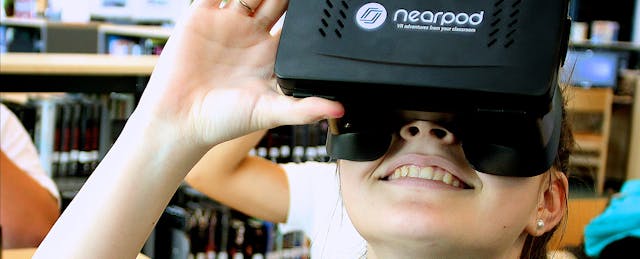Nearpod, which offers a suite of tools for teachers to create and share multimedia-rich lessons, presentations and digital activities with students, has raised $21 million in a Series B round led by Insight Venture Partners.
A flurry of existing investors also chipped in, including Reach Capital, Krillion Ventures, AGP Tech, GSV Acceleration Fund, Storm Ventures, the Stanford-StartX Fund, the Knight Enterprise Fund, Arsenal Ventures, Marc Benioff, Scott Cook and his wife, Signe Ostby. Nearpod has now raised $30.2 million in venture capital.
The funding will be used to “put a senior team in place” and “bring the skills and talents we need to talk to different stakeholders, such as administrators,” says Guido Kovalsky, the company’s CEO and co-founder, in an interview. “The more we grow, and the more we talk about district-wide implementations, the more we need to bring different talent with knowledge of state standards and curriculum expertise,” he adds.
Founded in 2012, Nearpod initially launched its “interactive lecture” platform for iPads, at a time when many schools and districts swooned over the tablets. The company has since expanded its platform to be compatible with all devices. The app initially focused on allowing teachers to build their own multimedia-rich presentations and assessments, beam them to students’ devices, and monitor their activities.
Today the company also offers a marketplace of nearly 4,000 interactive lessons, built with partner organizations like ReadWorks and Common Sense Education to tackle topics ranging from reading to digital citizenship. At any time the company works with 30 to 60 publishers to create these offerings, some of which are available for a fee. Nearpod recently teamed with Miami-Dade County Public Schools to create more than 500 lessons for non-native English speakers.
Recently the company has also ventured into virtual reality, collaborating with 360 Cities to provide students with 360-degree tours of volcanoes, historic Roman sites, Mars and other experiences. To introduce schools to this emerging medium, the company now also offers low-cost VR headsets. They require a smartphone or iPod Touch that is inserted into the gear.
Virtual reality in education “is definitely not a fad, but there’s definitely a lot of hype,” Kovalsky acknowledges. But “at the core, anything that gets kids more excited in learning is something we should consider. When a kid is engaged, discipline becomes a secondary problem.” He recognizes that there are “valid health concerns” with headsets and combined with a lack of quality, inexpensive content.
From adoption in 20 schools and districts a few years after launch, NearPod now claims usage in nearly 12,000 schools, or roughly 1 in 10 in the U.S., according to Kovalsky. More than 3.5 million students are using Nearpod on a monthly basis, he adds, along with 100,000 teachers. Roughly 20 percent of users hail from abroad in English-speaking countries including Canada, Hong Kong, Singapore and the U.K., despite the fact that Nearpod does not plan to focus on these markets in the foreseeable future.
Along with the user growth is a “three-year revenue growth rate of 1,320 percent,” according to the press release, although Kovalsky wouldn’t specify dollar figures. The company is currently not profitable, he states.
“At the core of our success,” he credits, “is all these teachers who have gone out of their way to incorporate NearPod, give it their own spin, and spread them to teachers and administrators,” says Kovalsky. The company currently runs a “PioNear” program that consist of educators who help travel, spread the word and train other teachers on using the tool. The company offers these educators financial support in return.
Yet teachers can only go so far to building the relationships and notching the deals needed to build a profitable company. It’s one of the important lessons Kovalsky says he’s learned during the journey—one that speaks to the “innate complexity” of the edtech industry.
“A teacher’s world is focused on a classroom of students, which is complex enough of a problem. Administrators worry about budgets, standards, privacy and whether these companies are going to stay for the long run. They look at the bigger picture of how your tool fits with all the others [a school] also uses,” he observes.
With offices in San Francisco and Miami, Nearpod looks to grow beyond the 40 to 50 employees on its team, says Kovalsky, especially as it looks to add people with deep knowledge of the K-12 administrator mindset.
The company will welcome other additional faces as well. In leading the round, Insight Venture Partners gained three seats on Nearpod’s board of directors. “Their expertise in supporting K-12 companies that are growing is unmatched,” Kovalsky effuses. Insight’s K-12 edtech investments include Achieve3000, a digital literacy provider; BrightBytes, an analytics tool that help administrators make data-informed decisions; and Illuminate Education, which offers data reporting and assessment solutions for districts. Other high-profile assets include Instructure, Turnitin and Pluralsight, which is highly anticipated to go public soon.
That track record seems to bode well for Kovalsky and the dozen of investors who are backing him. “It’s not everyday that we see companies reaching this milestone,” he says.


